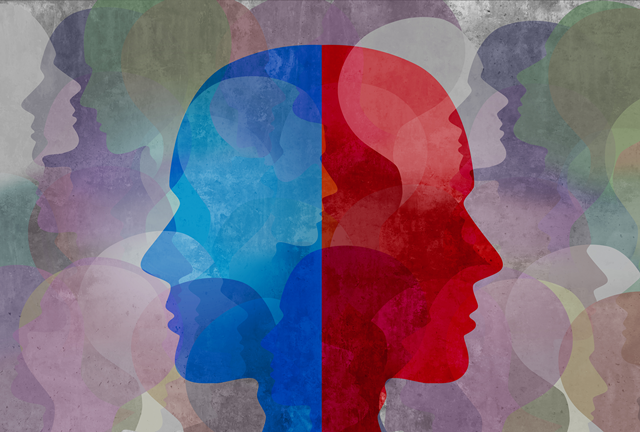Borderline Personality Disorder (BPD) is a complex and frequently misunderstood mental health condition that can have serious consequences on a person’s life.
Despite being one of the most common personality disorders, with estimates indicating that up to 2% of the general population may be affected by BPD, it is still covered in stigma and misinformation.
However, BPD is a treatable condition. People with BPD can learn to manage their symptoms, develop healthy relationships, and lead fulfilling lives with the right support and treatment.
Therefore, understanding and acceptance, as well as seeking professional help, are necessary for recovery.
Whether you or someone you know is suffering from BPD, you must remember that help is available and that recovery is possible. So, if this is the case, take a step forward, seek help, and begin your path to a brighter future.

What Is Borderline Personality Disorder (BPD)?
Borderline Personality Disorder (BPD) is a mental health condition characterized by a pervasive pattern of instability in moods, interpersonal relationships, self-image, and behavior. This instability can lead to impulsive and reckless conduct and intense and unstable emotions.
Individuals with BPD may experience emptiness, fear abandonment, and struggle to maintain stable relationships. These symptoms can make daily life very difficult and cause significant distress.
BPD is a complex condition that requires professional treatment. But with the right support, those suffering from BPD can learn to manage their symptoms and lead fulfilling lives.
Read: Do I have an Anxiety Disorder?
Innovative Tech Solutions, Tailored for You
Our leading tech firm crafts custom software, web & mobile apps, designed with your unique needs in mind. Elevate your business with cutting-edge solutions no one else can offer.
Start NowCharacteristics of Borderline Personality Disorder (BPD)
Here is what BPD looks like in people suffering from the mental health disorder:

Intense and Unstable Emotions
People with BPD have intense and rapidly changing emotions. They also frequently react to situations with extreme emotions that are out of proportion to the situation.
These individuals may also have strong feelings of rage, anxiety, and depression. Emotional instability can make daily life difficult and lead to rash behavior.
Fear of Abandonment
Individuals with BPD have a strong fear of abandonment and may go to great lengths to avoid being alone or feeling rejected. They may have intense and turbulent relationships, often idealizing others and then quickly turning against them.
Volatile Relationships
People with BPD often have difficulties with relationships, including intense and unstable relationships with family, friends, and romantic partners. They may struggle with trust and intimacy, leading to conflicts and frequent breakups.
Impulsive Behavior
Those with BPD may engage in impulsive and reckless behavior, such as binge drinking, binge eating, substance abuse, and even self-harm. These behaviors are often attempts to alleviate feelings of emotional pain and emptiness.
Read: Why is Good Hygiene Essential for Health?
Difficulty in Holding Down a Job and Achieving Goals
Due to intense and unstable emotions and relationships, people with BPD often struggle to maintain stable relationships, hold a job, and achieve their goals. They may also have a distorted sense of self, leading to difficulties in decision-making and self-esteem issues.
Seamless API Connectivity for Next-Level Integration
Unlock limitless possibilities by connecting your systems with a custom API built to perform flawlessly. Stand apart with our solutions that others simply can’t offer.
Get Started
Read: The Meaning and Causes of Schizophrenia
Misconceptions About Borderline Personality Disorder
Below are some myths about borderline personality disorder that should be dispelled. It’s important to eliminate these misconceptions to reduce stigma and ensure those suffering from this condition get adequate help.
BPD is Not a Real Disorder
One of the most persistent misconceptions about BPD is that it is not a real mental health condition. This is far from the truth, as the American Psychological Association recognizes BPD as a valid mental health disorder and is included in the Diagnostic and Statistical Manual of Mental Disorders (DSM-5).
That BPD is Merely Attention-Seeking Behavior
Another common misconception is that individuals with BPD are just seeking attention or making a show of themselves.
However, this is not the case. People with BPD struggle with intense and unstable emotions that can lead to impulsive behavior. And they often engage in these behaviors to manage feelings of emotional pain and emptiness.

BPD is Caused By a Traumatic Childhood
While a traumatic childhood can increase the likelihood of developing BPD, it is not the sole cause. BPD is a complex condition caused by a combination of genetic, environmental, and developmental factors.
BPD is Untreatable
Another misconception about borderline personality disorder is that it is an untreatable condition. This is not true.
While BPD can be challenging to treat, effective treatments are available, including therapy, medication, and support groups. With the right treatment and support, individuals with BPD can learn to manage their symptoms.
Transform Business with Custom CRM & ERP Solutions
Elevate your operations with a CRM or ERP tailored for you. Let’s build the perfect solution that others can't replicate—crafted to match your business's needs like no other.
Get StartedPeople with BPD Cannot Enjoy Healthy Relationships
This is another damaging misconception about BPD. While individuals with BPD may struggle with trust and intimacy, they can develop healthy relationships with the right treatment and support.
Overall, it is important to educate ourselves about BPD to remove harmful misconceptions and support those affected by the condition.
We should also know that people with BPD deserve to be treated with the same understanding and respect as everyone else.
By learning the truth about the condition, we can help to reduce stigma and support those affected by it.
Borderline Personality Disorder and Other Mental Health Conditions
Borderline Personality Disorder (BPD) is a complex mental health condition often confused with other mental health disorders. This confusion can result in a misdiagnosis, leading to inappropriate treatment and a delay in recovery.
Here are some of the most common mental health conditions that are confused with BPD and help to clarify the differences:

Bipolar Disorder
Bipolar Disorder is a mood disorder characterized by extreme changes in mood, energy, and activity levels.
Read: What Does Bipolar Disorder Mean?
While both BPD and Bipolar Disorder involve mood swings, the key difference is that in Bipolar Disorder, the mood swings are more pronounced and last for longer periods. In BPD, mood swings are more rapid and intense but usually last for a shorter period.
Depression
Depression is a mental health condition characterized by persistent feelings of sadness and loss of interest in activities.
Tailored Tech Solutions to Drive Your Business Forward
Maximize your business potential with custom tech strategies. We deliver bespoke solutions that others can’t match, designed to solve your specific challenges with precision and impact.
Contact UsWhile individuals with BPD may experience depression, these conditions are not the same. BPD involves a broader range of symptoms, including impulsive behavior, intense and unstable emotions, and distorted perceptions of self and others.
Post-Traumatic Stress Disorder (PTSD)
PTSD is a mental health condition that can develop after exposure to a traumatic event. Although both BPD and PTSD can be related to traumatic experiences, they are not the same condition.
Read: What is Post-Traumatic Stress Disorder (PTSD)?
In BPD, the symptoms are not limited to the aftermath of a traumatic event but are present in a person’s everyday life.
Narcissistic Personality Disorder (NPD)
NPD is a personality disorder characterized by a sense of pretense and a lack of empathy for others. While both BPD and NPD involve issues with self-image and relationships, the key difference is that in BPD, individuals struggle with intense and unstable emotions and a distorted sense of self. Whereas individuals with NPD have an exaggerated sense of self-importance and a lack of empathy.
Treatments for Borderline Personality Disorder
If you or someone you know suffers from borderline personality disorder, please know that treatment and help are available. Here are some options to consider.

Psychotherapy
Psychotherapy is the primary treatment for BPD. This treatment method involves talking with a mental health professional to understand and manage symptoms.
Different types of psychotherapy have been found to be effective for BPD. This includes Dialectical Behavior Therapy (DBT), Cognitive Behavioral Therapy (CBT), and Mentalization-Based Therapy (MBT).
DBT and CBT focus on teaching individuals coping skills to manage emotions, while MBT focuses on helping individuals understand their own feelings and thoughts.
Medication
While medication is not a cure for BPD, it can help manage some of the symptoms, such as anxiety and depression.
Antidepressants and mood stabilizers are commonly prescribed for individuals with BPD. But it is important to remember that medication should be used in conjunction with psychotherapy for the best results.
Support Groups
Support groups can be a helpful addition to treatment, allowing individuals with BPD to connect with others who understand what they’re going through. These groups can provide a sense of community and help individuals with BPD feel less isolated.
Hospitalization
In severe cases, hospitalization may be necessary to provide a safe and stable environment for individuals suffering from BPD. Hospitalization can help manage symptoms and provide a supportive environment for recovery.
However, BPD treatment is long-term, and people should not expect a quick fix. But instead, go through the treatment processes patiently and await a positive result.
The Journey to Recovery from BPD
It may seem long, but with the right roadmap, people with BPD can get better. Here’s how to get recover from borderline personality disorder.
Getting a Proper Diagnosis
The first step in the journey to recovery is getting a proper diagnosis. A correct diagnosis is essential to receive the appropriate treatment. Go all out to seek help from a mental health professional who has experience in diagnosing and treating BPD.
Finding the Right Treatment
There are several effective treatments for BPD. Work with a mental health professional to find the right combination of treatments that works best for you.
Developing a Support System
A support system is crucial in the journey to recovery. This can include family, friends, support groups, and a mental health professional.

Having a support system can provide a sense of community and help individuals with BPD feel less isolated.
Learning Coping Skills
Learning coping skills is an important part of the journey to recovery. This can include learning to manage emotions, recognize and change negative thought patterns, and improve relationships.
Psychotherapy, such as Dialectical Behavior Therapy (DBT) and Cognitive Behavioral Therapy (CBT), can be helpful in teaching individuals coping skills.
Before you go…
Hey, thank you for reading this blog to the end. I hope it was helpful. Let me tell you a little bit about Nicholas Idoko Technologies. We help businesses and companies build an online presence by developing web, mobile, desktop, and blockchain applications.
We also help aspiring software developers and programmers learn the skills they need to have a successful career. Take your first step to becoming a programming boss by joining our Learn To Code academy today!










